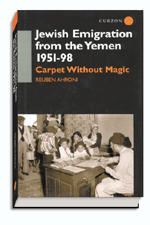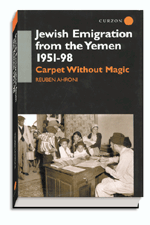
BOOK REVIEW Jewish Emigration from the Yemen 1951-98: Carpet Without Magic [Archives:2001/33/Law & Diplomacy]
August 13 2001
Reviewed by
Nikola M. Sardelis (Oriental Institute, University of Oxford)

Historians of Yemeni Jewry mention several great waves of emigration (and sometimes even almost complete decimation) of the Jewish population of south-west Arabia at various stages in the region’s history. When the Byzantine Greek empire instigated its Christian Ethiopian ally to invade Yemen in 525CE, both to avenge the Jewish King Dhu Nuwas’ oppression of the kingdom’s Christian minority and to forestall Persian expansion in one of the ancient world’s most important trading outposts, they effectively brought to a close (through a policy of systematic ‘ethnic cleansing’) hundreds of years of increasing Jewish influence on the Himyarites and other south Arabian empires, which popular legend traced back to as early as the Sabaean period. (Paradoxically, however, contemporary Judaism had itself actually been heavily influenced by pre-Christian Hellenistic civilization, typified by the likes of the great Jewish historian Philo of Alexandria, Egypt, which was then ruled by the Greek Ptolemid successor state to the Macedonian Empire founded with the conquests of Alexander the Great).
Again, after having recovered in terms of size as well as cultural and economic significance in the medieval Islamic period Yemeni Jewish civilization (like its counterpart in the Moorish Spain of Moses Maimonides) experienced something of a renaissance, exemplified by scholarly masterpieces like Sadiah Goan’s translation and commentary of the Torah into Arabic and the once pervasive influence of Islamic philosophy and mysticism (Sufism) on Jewish ‘schools’ of thought such as the Kabalah and its cosmological system based on the inherent powers of numbers (a speculative, mathematical ‘science’ attributed to the ancient Greek philosopher Pythagorias).
During the first Ottoman occupation (1538 to 1635) , the Jews of Yemen were to suffer under a range of laws imposed by the Imam al-Mahdi in the 1670s, which had their basis in the 28 Conditions of the great Umayyad caliph Umar, provoking a Jewish led revolt in San’aa and their subsequent expulsion from the city to the Tihama coastal strip (the so-called Exile of Mauza).
A similar situation prevailed after the second Ottoman occupation (1882 to 1918), when the Imam Yahia promulgated a range of laws to reinforce the inferiority of Yemeni Jews vis-a-vis their Muslim neighbors (such as prohibiting them from bearing arms or riding horses – essential symbols of Islamic military society).
Interestingly, the Jews of Yemen faired well during both periods of Ottoman
rule, since that empire had generally pursued a policy of tolerance towards them throughout its domains (from its military and political power base in the Balkan peninsular to its outlying Arab possessions), precisely because it realized their value in strengthening the economy. (Consequently, Jewish emigration to Palestine in the late Ottoman period seems mainly to have been inspired by ‘Zionist’ ideals rather than repelling factors such as discrimination). In fact, history even records a number of occasions when Ottoman Jews in both Yemen and the Balkans superficially adopted the more ‘flexible’ Ottoman brand of (Hanafi) Islam while retaining many other distinct aspects of their cultural identity, illustrated by the Yemeni followers of the ‘false messiah’ Shabbatai Zevi of Smyrna (the Turkish Izmir) in the late 1600s and the Donme (‘turnouts’) of the late 1800s.
This is just one area in which the situation of Yemeni Jewry somewhat mirrored the once sizeable Jewish community of Salonika (Thessaloniki), the principal seaport of Ottoman Macedonia (which since the second Balkan War of 1912-13 has been divided between northern Greece and the Former Yugoslav Republic of the same name, with a small strip in south-western Bulgaria), although the Nazi Holocaust in the southern Balkans rather than voluntary emigration to Palestine was the main reason for the latter’s almost complete disappearance.
As interesting as the history and culture of Yemeni Jewry may be to a very select number of specialists (not least because it represents what people often regard as an ‘archaic’ (one could even say idealised) and isolated development of the community in a relatively marginal, highly conservative and tribalistic corner of the Arab world), why should the non-specialist layman or anyone from a non-Jewish background like myself even consider reading Professor Ahroni’s book in the first place? Well, to begin with it is directly related to what is now an extremely topical and politically charged issue, that of Jewish immigration from the far flung diaspora to the state of Israel, with all the problems concerning ‘new Jewish settlements’ on Palestinian Arab lands it raises.
Secondly, it graphically illustrates how the interest, rivalries and influence of ‘great world powers’ like the USA and Britain, as well as the international media and Jewish organizations in the west, can dramatically affect the experiences of what after 1951 was an otherwise insignificant and relatively obscure religious minority. Professor Ahroni’s work, while lacking an overtly analytical perspective on such issues, nevertheless touches on all of them by weaving together a graphic historical narrative which alternates between the local situation of the Yemeni Jews along with those trying to engineer their emigration, the political history of north (YAR) and south (PDYR) Yemen (such as the evacuation of British forces from the Aden protectorate following the pressures exerted by the increasingly militant Arab nationalism in the area), and the political history of mainstream developments in Egypt and the Middle East proper (like the Suez crisis and Arab-Israeli wars). He also discusses how the unification of the two Yemens and the Gulf War affected the situation of the few remaining Jews in the country.
One of the work’s underlying aims seems to be the drawing of a distinction between the enthusiasm of Yemeni Jews to emigrate from Yemen until the last year of the Operation Magic Carpet airlifts to Israel-Palestine and the marked reservations of many Jews who remained behind, principally in north Yemen (whom Ahroni calls “the Jewish remnants”). Despite his Yemeni-Jewish roots, Professor Ahroni tacitly avoids dogmatically attributing this reluctance to emigrate on the part of Yemeni Jews exclusively to the anti-emigration policies of the new republican regime (which, paradoxically, were indirectly inspired by its nationalist Arab ideology and the misguided fears that the ‘agents’ of western and Israeli based organizations seeking to contact, persuade, and then help Yemeni Jews emigrate were actually trying to create a ‘fifth-column’ with the express purpose of introducing Israeli forces into Yemen ) or the more localised restrictions placed on their movement by the likes of tribal sheikhs in isolated regions such as Sa’ada or the Haraz mountains. He explicitly recognizes the interplay of other factors such as the fear Yemeni Jews had of losing their privileged financial status or the adverse effects the secularist policies of the state of Israel would have on the traditional observance of their religious and social customs, not to mention the circulation of tales by Jewish but anti-Zionist Satmar missionaries to the effect that Yemeni Jews were being thrown out of the planes ostensibly bound for Israel-Palstine, as part of a ploy by the republican regime to rid itself of this burdensome minority. Professor Ahroni similarly takes great pains to balance stories of Muslim intolerance against Yemeni-Jews with those which emphasise the latters’ love of their native country and their peaceful co-existence alongside their non-Jewish neighbours, suggesting the beginnings of a more balanced, almost ‘revisionist’ perspective on the later history of Yemeni Jewry often propogated by official Israeli histories.
Well written and divided into coherent chapters, Professor Ahroni’s work also extensively utilizes many original documents and letters (some of which are included in appendices at the back of the book), bringing past events to life while definitely avoiding a pedantic scholarly approach. Unfortunately, however, those ignorant of the history of Yemeni Jewry may feel disconcerted by the absence of an introductory chapter on the community’s history and culture, placing more recent events into a broader historical context, although this work should probably be taken as an integral extension to his series of other books on this much neglected but extremely fascinating subject.
——
[archive-e:33-v:2001-y:2001-d:2001-08-13-p:./2001/iss33/l&d.htm]


